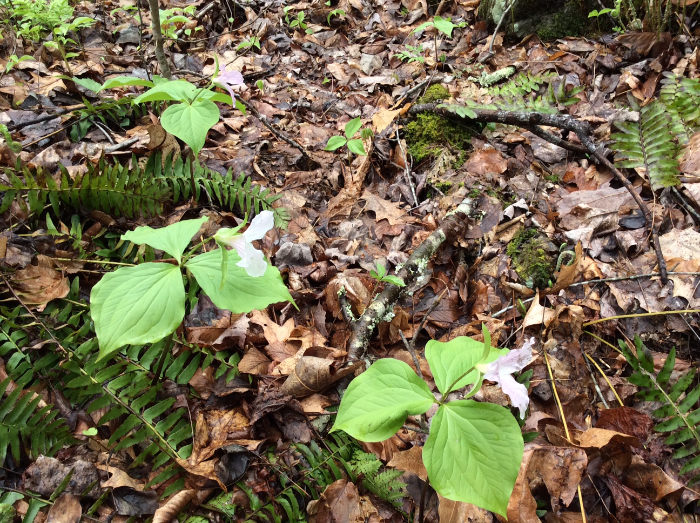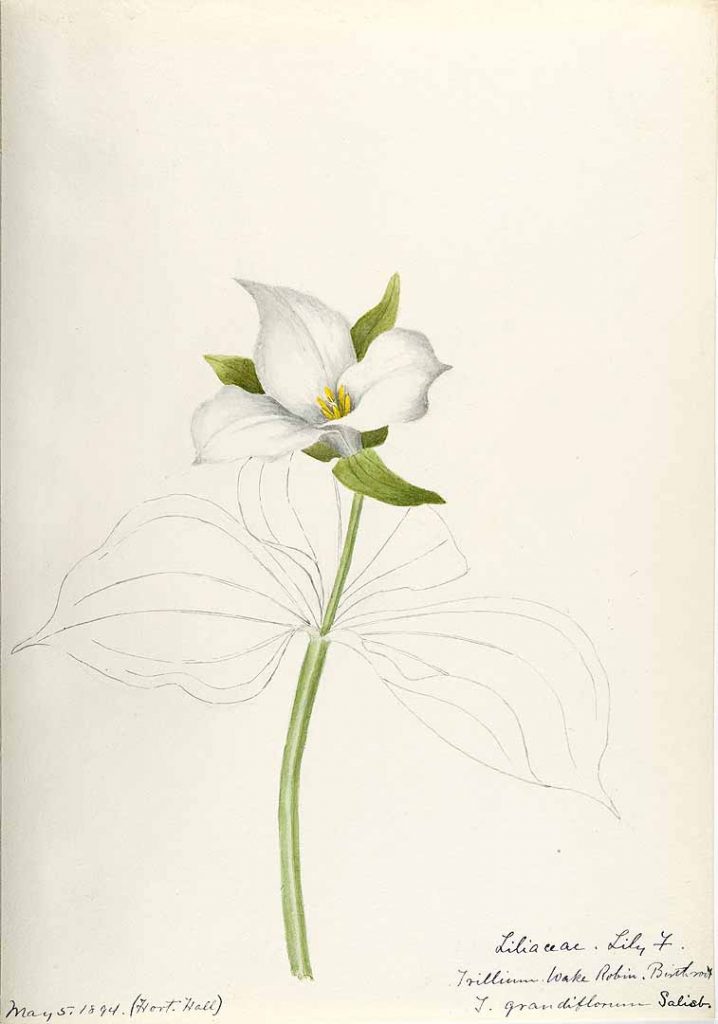
04.30.20 Trillium Trouble
 I usually go hunting for trillium, Trillium grandiflorum, in late April near my birthday. I love one particular walk in the Shenandoah National Park where, not far from the pull in, you can find solomon’s seal, trillium, stonecrop, and a number of other fabulous spring wildflowers. Driving to this spot last week resulted in being stopped by two Madison County sheriff’s deputies who let me know that due to the Covid crisis, the National Park was definitely and absolutely closed to visitors. At first disappointed, I soon remembered some other wild areas nearby and went in search of trillium blossoms in a state wildlife refuge. This hunting preserve turned out to be the perfect spot! I found many large colonies of trillium, all in their later stage of flowering as their white petals were gradually turning pink. Since the presence of trillium is in direct proportion to the scarcity of deer who love to eat this plant, a hunting preserve turned out to be much richer in trillium than the park with its heavy concentration of deer. All the better for the plant life! Another name for this plant is white wake-robin. Trilliums as a whole are divided into two groups, wake-robins with flowers on stems and toad-shades with flowers lacking stems and nestled tightly in the leaves.
I usually go hunting for trillium, Trillium grandiflorum, in late April near my birthday. I love one particular walk in the Shenandoah National Park where, not far from the pull in, you can find solomon’s seal, trillium, stonecrop, and a number of other fabulous spring wildflowers. Driving to this spot last week resulted in being stopped by two Madison County sheriff’s deputies who let me know that due to the Covid crisis, the National Park was definitely and absolutely closed to visitors. At first disappointed, I soon remembered some other wild areas nearby and went in search of trillium blossoms in a state wildlife refuge. This hunting preserve turned out to be the perfect spot! I found many large colonies of trillium, all in their later stage of flowering as their white petals were gradually turning pink. Since the presence of trillium is in direct proportion to the scarcity of deer who love to eat this plant, a hunting preserve turned out to be much richer in trillium than the park with its heavy concentration of deer. All the better for the plant life! Another name for this plant is white wake-robin. Trilliums as a whole are divided into two groups, wake-robins with flowers on stems and toad-shades with flowers lacking stems and nestled tightly in the leaves.
 Illustration of Trillium grandiflorum by Helen Sharp, 1894.
Illustration of Trillium grandiflorum by Helen Sharp, 1894.
 Josef Beery
Josef Beery I usually go hunting for trillium, Trillium grandiflorum, in late April near my birthday. I love one particular walk in the Shenandoah National Park where, not far from the pull in, you can find solomon’s seal, trillium, stonecrop, and a number of other fabulous spring wildflowers. Driving to this spot last week resulted in being stopped by two Madison County sheriff’s deputies who let me know that due to the Covid crisis, the National Park was definitely and absolutely closed to visitors. At first disappointed, I soon remembered some other wild areas nearby and went in search of trillium blossoms in a state wildlife refuge. This hunting preserve turned out to be the perfect spot! I found many large colonies of trillium, all in their later stage of flowering as their white petals were gradually turning pink. Since the presence of trillium is in direct proportion to the scarcity of deer who love to eat this plant, a hunting preserve turned out to be much richer in trillium than the park with its heavy concentration of deer. All the better for the plant life! Another name for this plant is white wake-robin. Trilliums as a whole are divided into two groups, wake-robins with flowers on stems and toad-shades with flowers lacking stems and nestled tightly in the leaves.
I usually go hunting for trillium, Trillium grandiflorum, in late April near my birthday. I love one particular walk in the Shenandoah National Park where, not far from the pull in, you can find solomon’s seal, trillium, stonecrop, and a number of other fabulous spring wildflowers. Driving to this spot last week resulted in being stopped by two Madison County sheriff’s deputies who let me know that due to the Covid crisis, the National Park was definitely and absolutely closed to visitors. At first disappointed, I soon remembered some other wild areas nearby and went in search of trillium blossoms in a state wildlife refuge. This hunting preserve turned out to be the perfect spot! I found many large colonies of trillium, all in their later stage of flowering as their white petals were gradually turning pink. Since the presence of trillium is in direct proportion to the scarcity of deer who love to eat this plant, a hunting preserve turned out to be much richer in trillium than the park with its heavy concentration of deer. All the better for the plant life! Another name for this plant is white wake-robin. Trilliums as a whole are divided into two groups, wake-robins with flowers on stems and toad-shades with flowers lacking stems and nestled tightly in the leaves. Illustration of Trillium grandiflorum by Helen Sharp, 1894.
Illustration of Trillium grandiflorum by Helen Sharp, 1894.